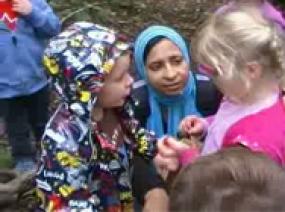To Team or Not To Team

Russell and Taylor have a little squabble over who will carry the wooden sign that the class has made. Taylor gets slightly physical, but Russell declares, “I’m never letting go.” The teacher shifts into “we have a problem” mode, using phrases the children recognize from similar situations. “Both of you would want to carry the board, yes?” This identifies the problem without specifying the solution. The teacher wants the children to think this through and is willing to stop the walk through the woods to allow the necessary time. The other children also wait because they too recognize this shift into the problem-solving mode and know that they too may need to contribute to the solution.
The teacher then frames the discussion as “what can we do?” Russell is quick to say, “We can share the work.” As equitable as this might sound, Taylor treats this as a rejection of her wish to be the sole carrier and replies, “No.” After a few “No – Yes” volleys between Russell and Taylor, the teacher decides to rule that this work requires more than one child. She says, “We need teamwork to carry this board.” This rule is presented as logic, given that the board is heavy. The teacher hopes that the objective fact of the board’s heaviness will offer Russell and Taylor a justification for working together. (In point of fact, one child could carry the board, at least for a short distance.) Taylor does not bow to this logic, perhaps because she has carried the board alone and certainly because she wants sole responsibility for the carry.
A third child (in the foreground) sings out that he wants to have teamwork. The teacher lists those who have agreed to have teamwork, perhaps in hopes that Taylor will reconsider and share the task. When Taylor once again refuses, the teacher emphasizes how much Taylor could help. Even after several appeals for her help, Taylor makes it clear that she is not interested in teamwork. The teacher respects her decision and lets the progress of this episode continue under the strategies the children invent.
Taylor backs away from the cooperative effort but does not complain. One senses that in spite of not getting her way, she feels that her desires were heard when expressed to the group. Russell and Nicholas carry the board, albeit awkwardly, since Nicholas, then Russell, walks backward. Around 01:39, Nicholas gives only perfunctory help, but is still participatory. At this point Russell asserts, “I can do it on my own,” but he does not reject the signatory hand of Nicholas. The teacher places the signboard that reads, “Big Kids Circle” at a branch of the path so others can find their way.
Was there any point in the episode at which you, as the teacher, would have made a different statement? What were your feelings for Taylor; for the other children? How might you use this episode to exemplify principles of dealing with conflict resolution?
Run time 2 minutes 14 seconds
